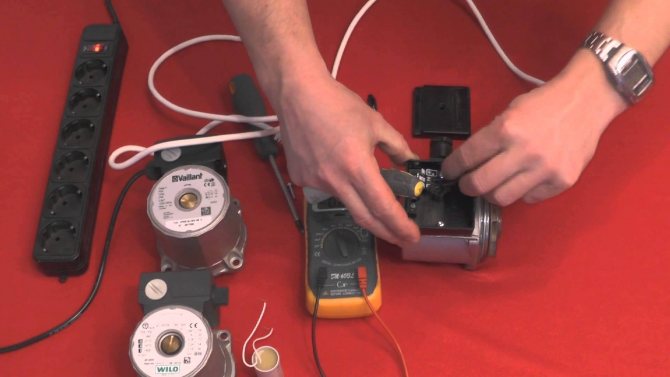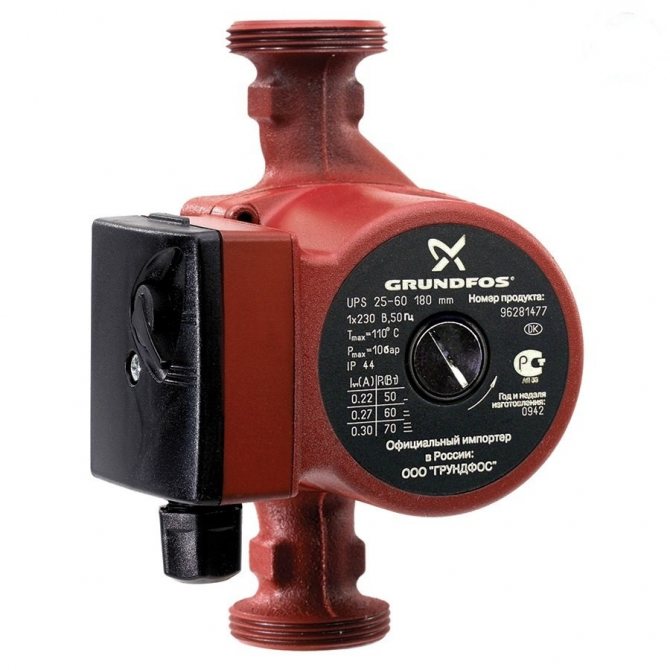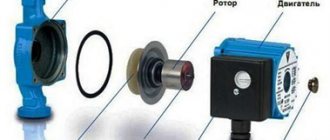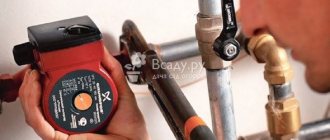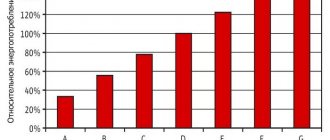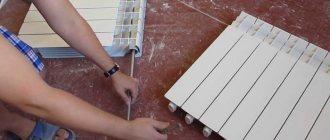Circulation pump operating rules
When using a circulation pump for heating, you should adhere to some rules:
- The pump must not run at zero flow. Therefore, you should constantly monitor its work.
- It is advisable to use the boiler frequently. With rare switching on, some elements may oxidize, and the device will be out of operation. It is recommended to turn it on for a short time at least once a month.
- If there is no water in the heating system, then the pump cannot be turned on.
- Check motor heating periodically. Do not allow the device to overheat excessively.
- Pumps often precipitate hard salts. To avoid this, it is necessary to control the temperature of the coolant. It should be less than 65 ° C. Then the circulation pump can work normally.
- It is necessary to check the connection of the electrical wires that are located in the terminal block.
- It is imperative to control the pressure of the water supply to the heating system. With a slow or strong flow, the pump may deteriorate its performance or completely cease to perform its function.
- It is necessary to check the pump housing and find out if there is a ground connection.
- Check pump operation periodically. This should be done based on the technical characteristics of the equipment.
- The pump must not make noise or vibrations during operation. The circulation pump should work without any noise.
- The pipe connections to the pump should be checked frequently. Sometimes the coolant leaks. If you have such a problem, then you need to replace the gaskets or tighten the connecting components. Leaks must not be allowed when the circulation pump is running.
Operating rules
To prevent breakdowns, observe the operating rules:
- it is forbidden to operate the pump for heating the house in the absence of water in the system;
- do not use the unit at zero flow;
- during operation, the delivery limits are respected;
- to prevent oxidation during downtime, the unit must be turned on for fifteen minutes;
- the temperature of the working fluid does not exceed sixty-five degrees Celsius;
- no leaks at the joints of the pipes;
- lack of heating of the unit;
- do-it-yourself pump installation occurs with horizontal shaft placement.
Pump problems and how to fix them
Any repair work can be carried out if the equipment is disconnected from the mains. And it is also necessary to pre-drain the site.
Consider what are the malfunctions of the circulation pump:
- If you turn on the pump, but the shaft does not start to rotate, a noise is heard. Why is there noise and the shaft does not rotate? If you did not turn on the pump for a long time, then the shaft could oxidize. It is necessary to check its serviceability. If the pump is blocked, it must be disconnected from the mains. Next, you need to drain the water and unscrew all the screws that connect the case and the electric motor. The impeller can then be turned by hand and the motor can be removed. Pumps with low power have special notches. They can be used to unlock the shaft. You just need to turn the notch with a screwdriver.
- Electricity problems. Often the pump is connected in disagreement with the voltage, which is indicated in the technical passport of the equipment. It is necessary to check if the voltage in your house matches the recommended one. And also it will not be superfluous to check the terminal box and all the connections in it. You should also check the phases.
- The wheel is blocked by a foreign object.In this case, you need to get the engine, as indicated in the first paragraph. In order not to get various objects into the wheels, you can install a special mesh filter in front of the circulation pump.
- If the pump starts up as usual and then turns off. In this case, deposits may be the cause. They form between the stator and the rotor. To fix the problem, remove the motor and descale the stator jacket.
- The pump does not start and does not hum. There may still be no tension. There can be two reasons: the motor winding has burned out or the fuse is damaged. First of all, you need to replace the fuse, but if, after replacing it, the pump does not start working, then the problem lies in the winding.
- The circulation pump vibrates during operation. This is often due to bearing wear. In this case, the pump is noisy. To fix the problem, the bearing must be replaced.
- A sharp noise appears when the pump is turned on. With such a problem, you need to release the air, and then install the air vent at the highest point of the piping.
- If the motor protection trips after starting the circulation pump? In this case, it is necessary to look for the cause in the electrical part of the engine.
- Often there is such a problem as improper water supply, as well as its pressure. In the technical passport of the equipment, the same values are indicated, and during operation, the pressure and flow differ significantly. This problem occurs in three-phase pumps due to incorrect connection.
- It is necessary to check the terminal box. And also check the fuse contacts for dirt. It will not be superfluous to check the resistance of the phases to ground.
What breakdowns are found and how to make repairs with your own hands
The operation of heating systems implies the possibility of servicing and eliminating many malfunctions by the efforts of the apartment owners. The circulation pump is no exception: the main thing is to understand its structure and principle of operation. You will also need some tools. Before disassembling the circulation pump, you must make sure that it is correctly connected to the mains. All parameters must comply with the instructions in the data sheet.
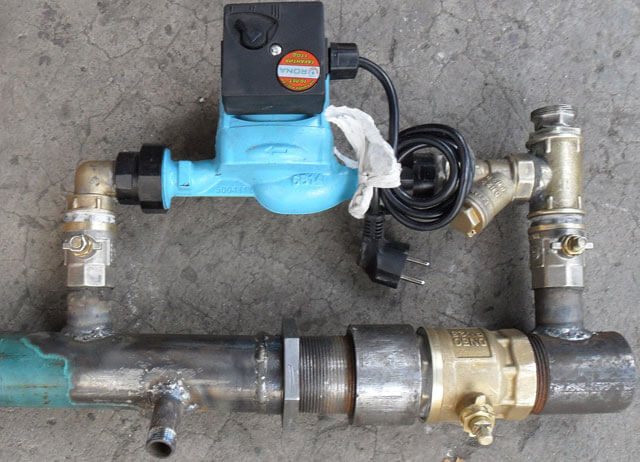
The most common malfunctions of the heating circulation pump are:
- The machine is making noise... The reasons for this phenomenon may be as follows: the motor shaft is covered with rust after winter storage of equipment, or a foreign object has got into the impeller. To solve the first problem, it will be necessary to disassemble the circulation pump - the pump is turned off before that. After that, the rotor must be turned several times. In the second case, everything is much simpler - the device is disassembled to remove a foreign body. In the future, it is advisable to acquire a protective mesh filter.
- The pump shaft has stopped rotating... First of all, using a tester, you need to check the device for the presence of voltage in it. Another common cause is connection errors. Most models are equipped with fuses that burn out during power surges.
- Unusual noise appears... The reasons for sounds uncharacteristic for the operation of a circulation pump are often air accumulated in the system. This kind of problem is solved by cleaning the pipes from air plugs. In order to never return to a similar situation, it is recommended to equip the upper section of the pipeline system with a special automatic unit. It will release air on its own as it accumulates.
- The pump has stopped starting... The most likely reason is the power outage. To eliminate it, it is necessary to check the correct switching of the phases and fuses. If everything is normal with this, it is possible that the drive winding has burned out.As a rule, an ordinary user is not able to eliminate such a breakdown, since it is not easy to disassemble the heating pump.
- After working for a few minutes, the device turns off... This may be due to incorrect phase wiring inside the terminal block. Another reason is that the fuse contact has oxidized, which needs to be periodically cleaned from slags.
- Strong vibration of equipment during operation... Most likely - the bearing is loose (it will need to be replaced from time to time). It is better not to carry out such a repair of the heating pump with your own hands.
How to disassemble a circulation pump
Before starting to disassemble the pump, it is necessary to perform preparatory steps:
- Using the indicator, you need to check the voltage.
- The fan is often blocked due to salts. They are deposited on the device due to the large amount of chemical impurities in the coolant.
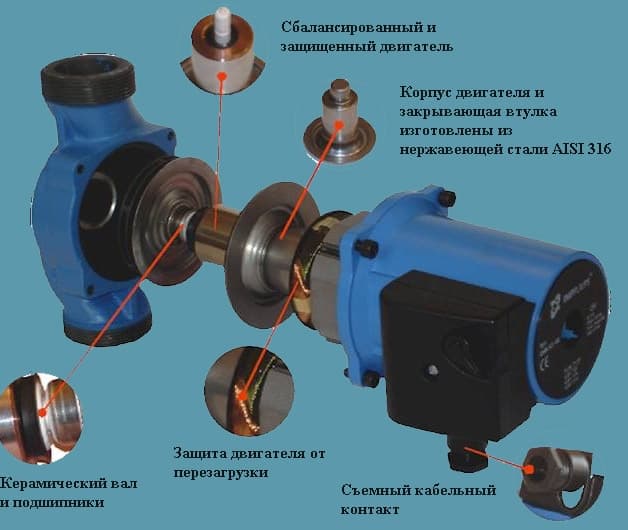

Many models cannot be disassembled. Therefore, you must first familiarize yourself with this issue.
Before disassembly, it is necessary: disconnect the heating equipment from the network, shut off the bypass, but leave the water circulation, and then you can dismantle the device.
Before buying a heater, you need to know in advance about the possibility of self-repair. You can find out from the seller about the availability of spare parts of the equipment. In many cases, it will be cheaper to replace the equipment with a new one than to repair the old one.
Pump structural elements
The basis of any device is its design. The circulation pump is not a very complicated device. It consists of several elements:
- body. It is a cylindrical product, for the manufacture of which brass, bronze, stainless steel or cast iron can be used. Any of these metals perfectly resists corrosive processes, which is extremely important given the proximity of the liquid to the device. In addition, the durability of these materials is also great. Cast iron is especially respected in terms of its durability - it can serve for more than half a century. But its problem is instability to temperature extremes. In principle, given the autonomy of the heating system of a private house, one can rely on their absence, since the operating mode is controlled by the owners of the dwelling. But still, force majeure happens, and they can lead to cracking of the cast iron. The other metals listed above do not have this problem. Of course, their cost is slightly higher, but you can not be afraid of sudden cracks on the pump housing,
- electric motor with a rotor. It is located inside the cylindrical body and is, in fact, the heart of the device. Engine power varies from model to model. In general, it is the main criterion for the selection of a circulation pump. The power indicator of the device must correspond to the needs of the specific heating system in which the device will be installed. Otherwise, it may not cope with the responsibilities assigned to it. Speaking of the rotor, it should be noted that it can be "dry" or "wet". The difference lies in its location. The "dry" rotor is housed in a separate pump unit, where it is reliably protected from direct exposure to liquid. Wet, on the other hand, is placed directly into the coolant. When choosing a specific device, it is important to know that "dry" varieties have a much higher performance, their efficiency is about a third higher than that of "wet" ones. But they have a very important drawback - a high noise level. The hum emitted during the operation of such a rotor can cause significant inconvenience to people even in the daytime. What can we say about the night when the sounds are carried many times better. In general, such a device is not recommended to be placed near living rooms, since the discomfort of people will be very great.Dry rotor circulation pumps can be installed in a separate boiler room, which is located away from the bedrooms. If it is not possible to equip such a room, or the dimensions of the house do not allow to seriously delimit the residential and non-residential part of the building by distance, then it is better to install a pump with a "wet" rotor in the system. It will consume more resources due to lower efficiency, but it will not get on your nerves with constant strong noise,
- impeller with blades. It is due to the latter that the coolant moves. The wheel, located on the rotor and made of durable stainless materials, starts to rotate when the electric motor is turned on. In this case, the blades scatter the liquid along the walls of the cylinder, from where it then goes into the pipeline under the influence of centrifugal force. At the same time, the pressure level drops sharply, which results in the flow of a new portion of liquid.
As you can see, both the design of the circulation pump and the general principle of its operation are not particularly difficult to understand. It's pretty simple. Thanks to this, many types of work with this equipment, such as preventive maintenance and repair, can be carried out even without any experience.
Preventive examination


In order for the operation of the circulation pump to be problem-free, it is necessary to regularly check the condition of the equipment. A routine examination will help identify negative factors that can lead to serious damage in the future. Their timely elimination will allow avoiding force majeure situations and complicated repair procedures.
A standard inspection includes a few simple steps:
- check the tightness of the connections. Carefully inspect all fittings that attach the pump to the heating system. Certain types of connectors can loosen over time and need to be tightened. In addition, there may be problems with the destruction of the thread or seal - in this case, you need to unscrew the fitting, cut additional turns or wind a new layer of FUM tape, and then reassemble the element,
- adding grease. There are bearings inside the device, which must be well lubricated. Otherwise, they will work worse, which will lead to overheating of the device,
- cleaning the filter. The mesh element is gradually clogged with dirt, even if you use a very high-quality heat carrier. Therefore, it is necessary to promptly remove rust and scale particles stuck in the filter.
Actually, this is the basic set of actions that must be performed for prevention. In addition, some rules for operating the circulation pump should be observed:
- avoid dry running. The pump should be turned on only if the required amount of coolant is present in the heating system. The equipment working "dry" will burn out very quickly, moreover, it can drag along with itself some other electrical appliances,
- do not allow long periods of inactivity. In many regions, the heating system operates seasonally - from September to May. It is clear that there is no point in running it in a thirty-degree heat. But with such a long idle time, some elements of the circulation pump may fail. Therefore, it must be turned on at least once a month for a quarter of an hour. Agree, it takes a little time, but it will help to avoid possible problems in the future,
- initially purchase a pump whose characteristics fully meet the needs of your heating system. It so happens that the owners, in an attempt to save money, buy a low-power device and try to use it in a system with a large volume of coolant. As a result, the device constantly works at the limit of its capabilities and, of course, breaks down very quickly.That is why it is important to make calculations of the parameters in advance, which should be guided by when buying. You can find information on how to do this on our portal,
- provide for overheating and dry running sensors. These regulators are not available on all models, but it is advisable to find and purchase a device with them. On your own, you may not immediately notice the problem that has arisen. For example, if a coolant leak has occurred in the system, then while you find it, the pump will run idle and may simply burn out. And the sensor will react instantly, automatically turning off the equipment, and thereby prevent damage.
The principle of operation and the device of the circular pump
In order to start repair work with the device, you need to know more about it. More precisely, you need to find out the design features of this device. Let's briefly show the main design features of the pump:
- The case is often made of stainless steel, there may be a variant that is made of non-ferrous metal.
- The presence of an internal engine, combined, necessarily by a shaft with a rotor.
- Rotary mechanism. A fan will always be installed on it, which is an impeller (the impeller blades are constantly in contact with water, which is why they are made specially from polymer or metal).
What are the features in the workflow? We do not take into account the subtleties of the structures:
- Electricity is supplied to the device itself, after which the engine is activated and begins to work together with the rotor. After that, it is the rotor that gives motion to the impeller.
- Further, the liquid begins to flow into the pipe. After that, the blades constantly throw liquid onto the walls of the body.
- Here centrifugal force is generated, which in turn makes pushing through the pipe.


By the way, do not forget about the presence of a pump, which, depending on any type of construction in which it is installed, can be different. For example, consider a variant of a device with a rotor:
- dry look;
- wet look.
If the pump is installed in a wet area and it necessarily has a rotor, then the device will cool. It will play a certain role as a lubricating element. It is this setting that is often used in household systems. It is also worth noting the main features that should not be forgotten.
- During operation, the pump practically does not make noise, due to the fact that the liquid has the ability to drown out any noise and vibration.
- When viewed from the installation side, the installation is extremely simple. And its maintenance is also quite simple.
But where there are features, that is, strengths, there are always disadvantages, and these include:
- Very low efficiency.
- Although simple to install, it can only be done horizontally
- Without the presence of water, it is strictly forbidden to start the pump.
We examined the type of a wet pump, but what about a dry one? The dry pump has a motor that is housed in a dedicated separate chamber. With the help of the clutch, the movement is transmitted by the shaft. The transfer takes place directly to the impeller.
If we compare the dry look with the wet one, then the dry ratio is about 85%. It also differs in that it has a more complex structure. It is because of this, in turn, that the design makes the repair process more difficult. With regard to installation.
The installation can be carried out as follows: the pump is soldered, you can also screw it in or even weld it into the pipeline, after which everything is installed on the wall. In order to securely fasten it to the wall, you will need special fasteners.
